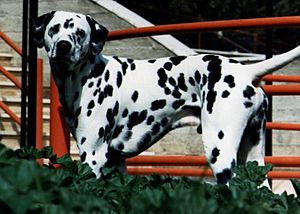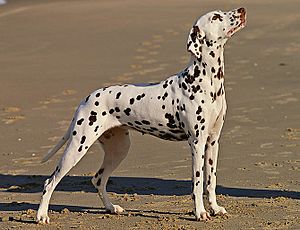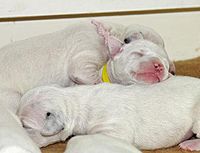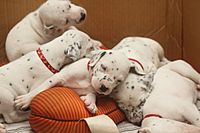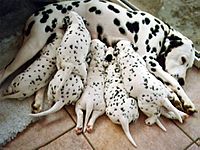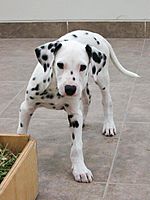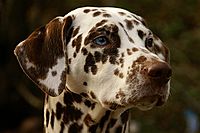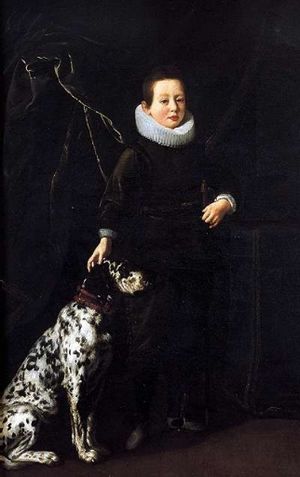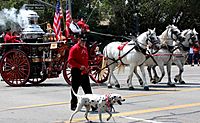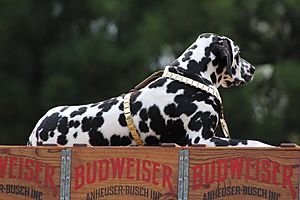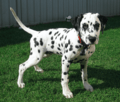Dalmatian (dog) facts for kids

Liver-spotted Dalmatian
|
|||||||||||||||||||||||||||||||||
| Other names | Carriage Dog Coach Dog English Coach Dog Spotted Coach Dog Firehouse Dog Plum Pudding Dog |
||||||||||||||||||||||||||||||||
|---|---|---|---|---|---|---|---|---|---|---|---|---|---|---|---|---|---|---|---|---|---|---|---|---|---|---|---|---|---|---|---|---|---|
| Common nicknames | Dal, Dally | ||||||||||||||||||||||||||||||||
| Origin | |||||||||||||||||||||||||||||||||
|
|||||||||||||||||||||||||||||||||
|
|||||||||||||||||||||||||||||||||
| Domestic dog (Canis lupus familiaris) | |||||||||||||||||||||||||||||||||
The Dalmatian is a famous dog breed known for its unique spotted coat. It gets its name from the Dalmatia region in Croatia, where it is believed to have first appeared. For a long time, people didn't know exactly where this breed came from. Dalmatians have had many jobs throughout history! They've been war dogs, fire department mascots, and even helped shepherds. However, they are most famous as "coach dogs" or "carriage dogs." They would run alongside horse-pulled vehicles, guarding them and their passengers. Dalmatians also worked as circus performers, helped hunt small pests, followed fire trucks, and acted as guard dogs.
Contents
Where Did Dalmatians Come From?
There are many ideas about where the Dalmatian breed began. Dogs with spots have been seen throughout history in Africa, Europe, and Asia. Some people think spotted dogs lived in ancient Egypt. In the 1700s, a dog called the Bengal pointer was popular in England. It looked a bit like the Dalmatian.
Many believe the Dalmatian truly comes from Croatia. During the Middle Ages, they were used as hunting dogs. The breed became very popular in the 1800s as carriage dogs. They would run next to horses and carriages, following their owners. They also guarded the carriages and horses when their owners were busy.
What Do Dalmatians Look Like?
The Dalmatian is a medium-sized, strong, and muscular dog. Its head is flat on top. The part of its face that holds the nose and mouth (called the muzzle) is almost as long as the top of its head. A Dalmatian's nose can be black, brown (liver), blue, or a dark gray that looks black. Their round eyes can be brown, blue, or sometimes one of each color!
Their toenails are usually white or black if the dog has black spots. If the dog has liver-colored spots, their nails are brown or white. Dalmatian puppies are born completely white. Their famous spots appear a few weeks after they are born.
Adult Dalmatians usually stand about 19–23 inches (48–58 cm) tall.
About 8% of Dalmatians are born deaf. Some can also lose part of their hearing later in life. This can make them more expensive to care for.
Dalmatian Features and Traits
Body Shape and Size
Dalmatians are well-built, muscular dogs with great endurance and stamina. When they are fully grown, they usually stand between 19 to 23 inches (48 to 58 cm) tall. Male Dalmatians are often a little bigger than females. The Kennel Club in the UK allows them to be up to 24 inches (61 cm) tall. Their body is about as long as they are tall. Their feet are round with nicely arched toes. Their nails are usually white or the same color as their spots. Their thin ears are set high on their head and taper to a point. Eye color can be brown, amber, or blue. Some Dalmatians even have one blue eye and one brown eye!
Their Unique Coat
Dalmatian puppies are born with plain white coats. Their first spots usually show up within 3 to 4 weeks after they are born. After about a month, they have most of their spots. However, new spots can continue to appear slowly throughout their lives. The spots are usually between 30 to 60 mm in size. They are most commonly black or brown (liver) on a white background.
Other, rarer colors include blue (a blue-gray color), brindle, mosaic, and tricolored. Tricolored Dalmatians have tan spots on their eyebrows, cheeks, legs, and chest. Orange or lemon spots (dark to pale yellow) can also occur. Sometimes, a Dalmatian might have a large patch of solid color on its body, usually on its head or ears.
The Dalmatian's coat is usually short, fine, and thick. However, some Dalmatians can have longer coats. These long-coated dogs shed less than the common short-coated ones. Short-coated Dalmatians shed a lot all year round. Their stiff hairs can be hard to remove from carpets, clothes, and furniture. Brushing them weekly with a special mitt can help reduce shedding. Dalmatians don't have a strong "dog smell" because their coats have very little oil. This means they stay quite clean compared to many other dog breeds.
How Many Puppies?
Dalmatians usually have litters of six to nine puppies. But sometimes, they can have much larger litters. For example, one Dalmatian had eighteen healthy puppies in January 2009!
- Puppies don't have spots in the beginning
Dalmatian Health Concerns
Dalmatians are generally healthy dogs and are not too difficult to care for. However, like all dog breeds, they can have certain health problems. These include deafness, allergies, and kidney stones. Good breeders test their puppies' hearing using a special test called BAER.
The Dalmatian Club of America says Dalmatians usually live between 11 and 13 years. Some can even live as long as 15 or 16 years. Surveys show their average lifespan is around 9.9 to 11.55 years. As they get older, in their late teens, both male and female Dalmatians might develop bone spurs and arthritis. A condition called autoimmune thyroiditis, which affects the thyroid gland, is also somewhat common in the breed.
Deafness in Dalmatians
Deafness is a serious health issue for Dalmatians. Only about 70% of them have normal hearing. Early breeders didn't know about this problem, so they sometimes thought Dalmatians were not smart. Even after realizing it was a genetic problem, breeders still faced challenges. Deafness continues to be a common issue in the breed.
Scientists now know that deafness in white or spotted animals is caused by a lack of special cells (melanocytes) in the inner ear. This can affect one ear or both. This condition is also common in other dog breeds with light coloring, such as Bull Terriers, Dogo Argentinos, Poodles, Boxers, Border Collies, and Great Danes.
Usually, only Dalmatians with normal hearing in both ears are used for breeding. However, dogs with hearing in only one ear, or even those completely deaf, can still make wonderful pets with the right training. The Dalmatian Club of America suggests that deaf puppies should not be sold as pets. Dalmatians born with large patches of color might have a lower chance of being deaf. Breeding for this trait could help reduce deafness in the breed. However, large patches are often considered a fault in Dalmatian breed standards. This is to keep the famous spotted coat looking its best.
Blue-eyed Dalmatians are thought to have a higher chance of being deaf than brown-eyed Dalmatians. However, scientists are still studying why this might be. Some kennel clubs advise against breeding blue-eyed dogs.
The Dalmatian Heritage Project
The Dalmatian Heritage Project started in 2005. Its goal is to protect and improve the Dalmatian breed. They do this by breeding parent dogs with specific good traits:
- Normal body processes for their urinary system
- Good hearing in both ears
- A friendly and confident personality
All puppies in this project come from a special line of dogs developed by Dr. Robert Schaible. Today, "Dr. Schaible’s line produces the only Dalmatians in the world today that are free of a metabolic defect that can lead to urinary tract problems."
Dalmatian History and Jobs
The exact origins of the Dalmatian are still a mystery. In the late 1700s, there was a type of white spotted dog called the Talbot Hound. These dogs would travel with horse-drawn carriages and guard the people and their belongings. In 1791, a man named Thomas Bewick first called this type of dog a Dalmatian.
During the Regency period (early 1800s), the Dalmatian became a symbol of wealth and status. They would trot proudly alongside horse-drawn carriages. Dogs with especially beautiful spots were highly valued. This is why they earned the nickname 'the Spotted Coach Dog.' The breed was also used to guard stables at night.
The first unofficial rules for the breed were created in 1882 by an Englishman named Vero Shaw. In 1890, the first Dalmatian Club was formed in England, and these rules became official.
Many Different Jobs
This old breed has had many different jobs. They were used as war dogs, guarding the borders of Dalmatia. Even today, Dalmatians have a strong guarding instinct. While they are friendly and loyal to people they know, they can be a bit distant with strangers and other dogs. Dalmatians also have a strong hunting instinct and are good at getting rid of rats and other pests. In sports, they have been used as bird dogs, tracking dogs, retrievers, or in groups to hunt wild boar or deer. Their striking spots and intelligence have also made them successful circus dogs over the years.
Dalmatians are perhaps best known for working with firefighters. They served as escorts for fire trucks and as firehouse mascots. Dalmatians and horses get along very well. So, the dogs were easily trained to run in front of the horse-drawn fire carriages. They would help clear a path and quickly guide the horses and firefighters to the fires.
Dalmatians are also considered good guard dogs. They were useful to fire brigades for protecting the firehouse and its equipment. Old fire engines were pulled by fast horses, which could be stolen. So, Dalmatians were kept in the firehouse to scare away thieves.
Dalmatians in Pop Culture
The "Firehouse Dog"
Especially in the United States, Dalmatians became known as "firehouse dogs." They used to run alongside horse-drawn fire engines. Today, the Dalmatian is still a firehouse mascot. They sometimes help teach people about fire safety. In the past, they were very helpful because they naturally got along well with horses. They would run next to the horses or even under the cart axles. The horses are no longer used, but Dalmatians have stayed as a tradition. Many firefighters still choose Dalmatians as pets to honor their history. The Dalmatian is also the mascot for the Pi Kappa Alpha fraternity, which was once known as the firefighters' fraternity.
The "Anheuser-Busch Dog"
In the United States, Dalmatians are also linked to Budweiser beer and the Busch Gardens theme parks. The Anheuser-Busch company has famous beer wagons pulled by a team of Clydesdale horses. A Dalmatian always rides along with them! The company has several teams that travel around. Historically, brewers used Dalmatians to guard the wagon while the driver delivered beer.
101 Dalmatians
The Dalmatian breed became incredibly popular after the 1956 novel The Hundred and One Dalmatians by British author Dodie Smith. Later, two Walt Disney films based on the book made them even more famous. The Disney animated movie came out in 1961. Then, a live-action movie, 101 Dalmatians, was released in 1996.
After the sequel 102 Dalmatians came out, the breed faced problems. Many people bought Dalmatians without knowing much about them or how much energy they have. Many Dalmatians were abandoned by their owners and ended up in animal shelters. Because of this, groups were formed to rescue Dalmatians and find them new homes. The number of Dalmatians registered with the AKC dropped by 90% between 2000 and 2010.
Images for kids
See also
 In Spanish: Dálmata (perro) para niños
In Spanish: Dálmata (perro) para niños


